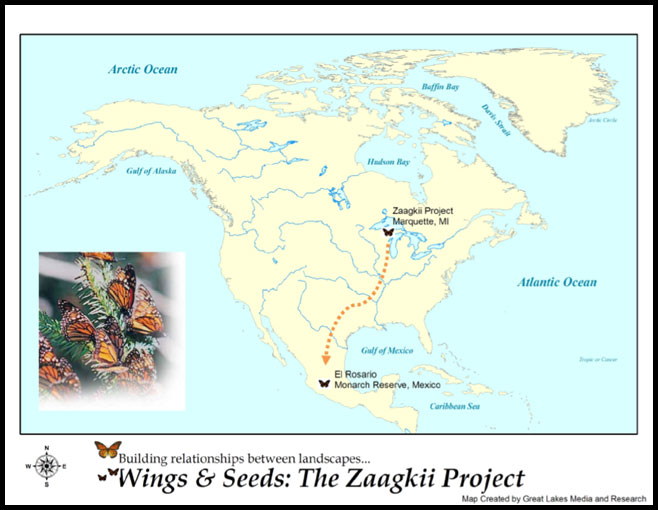Tentatively scheduled for October 2011.
Following the Monarch Butterfly
from Michigan to Mexico
October 2011
A small group of Native Americans and Youth Volunteers join the United States Forest Service and the Cedar Tree Institute on a journey into the mountain sanctuary of El Rosario.
 The Zaagkii Project is a collaboration between the Cedar Tree Institute, Marquette County Juvenile Court, the US Forest Service and the Keweenaw Bay Indian Community.
The Zaagkii Project is a collaboration between the Cedar Tree Institute, Marquette County Juvenile Court, the US Forest Service and the Keweenaw Bay Indian Community.
Its goal is to increase general awareness of the environment among select youth through hands-on education of pollinator species, such as bees and Monarch butterflies.
The Cedar Tree Institute (CTI) is considering sending a team consisting of a CTI representative, select youth from Michigan’s Upper Peninsula and staff from the US Forest Service on a trip to a Monarch butterfly sanctuary in Mexico. Some of the goals of the trip are to highlight the importance of pollinators and the shared environmental threats, struggles of indigenous peoples, and challenges facing today’s youth. Ultimately, the trip should forge lasting relationships between seemingly disparate cultures by making connections through the Monarch butterfly’s migration route. The Monarch, as a symbol of resurrection and transformation, represents an uplifting analogy to overcoming the difficulties and obstacles many youth face today.

The week-long trip is planned for late October/early November to coincide with the beginning of the arrival of Monarch butterflies to their over-wintering grounds in the Mexican states of Michoacán and Mexico. Traveling roughly 75 miles a day, some of these butterflies will have made the journey from Michigan’s Upper Peninsula, many of them launching from the Stonington Peninsula, on Lake Michigan.
Life cycle
There are four stages to the Monarch’s life cycle: the egg, the larvae (caterpillar), the pupa (chrysalis), and the adult butterfly. There are also four generations that the Monarch goes through during one year.
Migration
In order to escape the cold, harsh winters of the northern United States and Canada, the Monarch migrates south in the autumn. Monarchs in eastern North America migrate to the Sierra Madre Mountains of Mexico, while those in western North America (west of the Rocky Mountains) over-winter in California.
Pollination
According to the North American Pollinator Protection Campaign, “an estimated one out of every three bites of food we eat comes from a pollinator.”
While larval Monarchs feed exclusively on milkweed, adults require large amounts of nectar during peak seasons, such as their spring and fall migrations. While feeding, they help distribute pollen among many varieties of flowering plants. Without pollinators such as bees and butterflies feeding on nectar sources, 90% of flowering plants could not reproduce, which would greatly affect biodiversity and, in turn, the health of wildlife and humans.
Environmental Threats
The Monarch butterfly is being seen in record low numbers throughout North America and continues to face a number of threats to survival, primarily a dearth of milkweed, necessary to the Monarch’s survival, and deforestation at its wintering grounds in Mexico.
November 2 – Day of the Dead (Día de los Muertos)
This annual Mexican holiday is derived from the Catholic All Soul’s Day. The Day of the Dead represents a mix of both indigenous and Catholic tradition. Adherents believe that death is simply a transition from one life to another and that the living and dead have the ability to communicate during this holiday.
The arrival of the Monarchs at their wintering grounds coincides roughly with this holiday, leading regional indigenous groups, including the Mazahua and P’urhépecha (also spelled Purépecha; also often referred to as Tarascans) to associate the migrating Monarchs with the returning souls of the dead.
Help Support Youth Volunteers
The trip will cost $2,200 per youth volunteer. This includes:
- passport fees
- travel by jeep, bus, truck and foot
- lodging
- airfare
- food
- expenses
To make a contribution for the youth volunteers, click the button below and enter the amount you would like to give. The Cedar Tree Institute is a nonprofit 501(c3) organization.
All donations are tax deductible.

 Tree Hugger News Story on Zaagkii Project – entitled “Michigan Teens Build Butterfly Houses and Plant 26,000 Native Plants through the Zaagkii Wings and Seeds Project” posted Sunday, October 26, 2008 by Sara Novak, Columbia, SC.
Tree Hugger News Story on Zaagkii Project – entitled “Michigan Teens Build Butterfly Houses and Plant 26,000 Native Plants through the Zaagkii Wings and Seeds Project” posted Sunday, October 26, 2008 by Sara Novak, Columbia, SC.